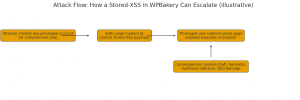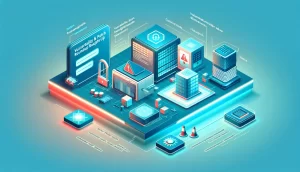
A dangerous new player has entered the ransomware arena, and its impact is already being felt across organizations worldwide. Known as “The Gentlemen,” this ransomware group combines sophisticated technical capabilities with a well-organized business model that’s proving highly effective at extorting victims.
Since its emergence in July 2025, The Gentlemen has rapidly scaled its operations, claiming 48 victims between September and October 2025 alone. This alarming growth rate positions them among the most active ransomware operators currently threatening enterprises.
What makes The Gentlemen particularly concerning isn’t just their volume of attacks—it’s their professional approach to cybercrime, advanced encryption techniques, and multi-platform targeting capabilities that make them a formidable threat to organizations of any size.
What Is The Gentlemen Ransomware?
The Gentlemen operates as a Ransomware-as-a-Service (RaaS) platform, representing the modern business model of cybercrime. In this structure, core operators maintain the ransomware infrastructure, negotiation processes, and leak sites, while recruiting affiliates who carry out the actual attacks.
This business model has several advantages for cybercriminals:
- Scalability: Multiple affiliates can launch attacks simultaneously
- Specialization: Operators focus on malware development while affiliates specialize in network compromise
- Risk Distribution: Affiliates take on the risk of initial access while operators remain insulated
- Revenue Sharing: Both parties profit from successful attacks
According to cybersecurity researchers at Cybereason, The Gentlemen didn’t appear overnight. Before launching their own RaaS platform, the operators experimented with affiliate programs from other prominent ransomware groups, learning from established operations and refining their tactics.
This experience shows in their sophisticated attack methodology and professional victim communication—hallmarks of seasoned ransomware operators.
Understanding Dual-Extortion Tactics: Why The Gentlemen Is More Dangerous
Unlike traditional ransomware that simply encrypts files and demands payment for decryption, The Gentlemen employs a dual-extortion strategy that creates multiple pressure points on victims:
First Extortion: Data Encryption
The ransomware encrypts critical files across your systems, making business operations impossible. Without the decryption key, your data remains locked and inaccessible.
Second Extortion: Data Theft and Leak Threats
Before encryption, attackers steal sensitive information from your network. They threaten to publish this data on their dark web leak site if you don’t pay. This stolen data might include:
- Customer databases and personal information
- Financial records and accounting data
- Intellectual property and trade secrets
- Internal communications and emails
- Contract details and business strategies
This dual-extortion approach is devastatingly effective because even if you can restore from backups (avoiding the first extortion), you still face potential regulatory penalties, customer lawsuits, and reputation damage from the data leak (the second extortion).
The Dark Web Leak Site
The Gentlemen maintains an active dark web leak site where they publicly shame victims and gradually release stolen data. This site serves multiple purposes:
- Pressure Tactic: Seeing your data appear publicly creates urgency to pay
- Proof of Compromise: Demonstrates they actually have your sensitive information
- Marketing Tool: Shows potential affiliates and other criminals their operational success
- Negotiation Leverage: Partial data releases during negotiation force compliance
Technical Analysis: How The Gentlemen Ransomware Works
Understanding the technical capabilities of The Gentlemen ransomware helps organizations better defend against it. Here’s what security researchers have discovered:
Multi-Platform Targeting
Unlike ransomware that focuses solely on Windows systems, The Gentlemen has developed specialized variants for:
- Windows environments: Targeting corporate desktops, servers, and domain controllers
- Linux systems: Compromising file servers, application servers, and development environments
- ESXi platforms: Specifically designed to encrypt virtual machine infrastructures
This multi-platform approach ensures attackers can compromise your entire IT environment regardless of your operating system mix.
Advanced Encryption Algorithms
The Gentlemen uses military-grade encryption that makes unauthorized decryption virtually impossible:
XChaCha20 Encryption: A modern stream cipher known for speed and security. This algorithm efficiently encrypts large files while maintaining strong cryptographic protection.
Curve25519 Key Exchange: An elliptic curve cryptography method used for generating encryption keys. This ensures only the attackers possess the private key needed for decryption.
The combination of these algorithms creates an encryption scheme that security experts consider unbreakable without the proper decryption key—meaning paying the ransom or restoring from backups are the only realistic recovery options.
Persistence Mechanisms
Recent updates to The Gentlemen ransomware have enhanced its staying power on compromised systems:
- Automatic Self-Restart: If the ransomware process terminates, it automatically restarts
- Run-on-Boot Functionality: The malware configures itself to execute automatically when systems restart
- System-Level Privileges: Runs under SYSTEM account with highest privileges
These persistence mechanisms ensure the ransomware continues its encryption process even if security teams attempt to stop it during an active attack.
Network Propagation: How The Gentlemen Spreads Across Your Infrastructure
Once The Gentlemen ransomware gains initial access to your network, it employs sophisticated lateral movement techniques to maximize damage:
Windows Management Instrumentation (WMI)
WMI allows remote execution of commands across Windows networks. The Gentlemen exploits this legitimate Windows feature to:
- Execute ransomware on remote systems
- Gather information about network topology
- Deploy encryption tools across multiple machines simultaneously
PowerShell Remoting
PowerShell remoting enables command execution on remote Windows computers. Attackers leverage this for:
- Rapid deployment across enterprise networks
- Automated encryption of network shares
- Credential harvesting for further access
Network Share Encryption
The ransomware specifically targets:
- Mapped Drives: Automatically discovers and encrypts all mapped network drives
- UNC Paths: Directly accesses network shares using Universal Naming Convention paths
- Domain-Connected Storage: Finds and encrypts shared storage accessible through Active Directory
This comprehensive approach to network propagation means a single compromised workstation can rapidly lead to organization-wide encryption.
Defense Evasion: How The Gentlemen Avoids Detection
The ransomware employs multiple techniques to evade security tools and complicate investigation efforts:
Disabling Windows Defender
The Gentlemen executes PowerShell commands to systematically disable Windows Defender protection:
- Turns off real-time monitoring
- Disables behavior-based detection
- Adds encryption directories to exclusion lists
- Adds ransomware processes to allowed applications
Firewall Manipulation
The malware modifies Windows Firewall rules to:
- Enable network discovery protocols
- Allow communication between compromised systems
- Facilitate lateral movement without triggering alerts
Service and Process Targeting
Before encryption begins, The Gentlemen terminates critical services and processes that might interfere with encryption:
Database Engines:
- Microsoft SQL Server (MSSQL)
- MySQL
- PostgreSQL
- Oracle Database
Backup Solutions:
- Veeam Backup & Replication
- Windows Backup services
- Shadow Copy services
- Archive utilities
Virtualization Services:
- VMware ESXi services
- Hyper-V management
- Virtual machine processes
By targeting these services, attackers ensure databases close properly (preventing corruption), backup processes stop (preventing recovery), and virtual machines shut down (allowing complete encryption of VM files).
Anti-Forensics Tactics: Covering Their Tracks
What sets The Gentlemen apart from less sophisticated ransomware is their focus on hindering incident response and forensic investigation:
Event Log Deletion
The ransomware systematically deletes critical Windows logs:
- Security Event Logs: Removes evidence of authentication and access
- System Event Logs: Erases records of service changes and system events
- Application Event Logs: Eliminates program execution history
RDP Connection Log Removal
Remote Desktop Protocol logs that would show attacker connection times and source locations are wiped, making it harder to determine:
- When attackers accessed systems
- Where attacks originated
- Which accounts were compromised
- Duration of unauthorized access
Windows Defender Evidence Elimination
The malware deletes Windows Defender support files that contain:
- Detected threat information
- Quarantine records
- Scan history
- Security intelligence data
Prefetch Data Destruction
Windows Prefetch files record program execution history. By deleting these, attackers remove evidence of:
- Which tools were executed
- When ransomware deployment occurred
- What preparation scripts ran before encryption
This comprehensive anti-forensics approach significantly complicates incident response efforts, making timeline reconstruction and threat hunting more challenging for security teams.
Password-Protected Execution: An Additional Layer
The Gentlemen ransomware requires a password argument to begin its encryption routine. This design choice serves several purposes:
- Prevents Accidental Execution: The ransomware won’t activate if discovered and opened by security researchers or analysts
- Controlled Deployment: Affiliates can position the malware across networks before simultaneous activation
- Evades Sandbox Analysis: Automated malware analysis systems can’t execute the ransomware without the correct password
- Coordination: Ensures encryption begins only when attackers are ready, maximizing impact
Industry Impact: Who Is At Risk?
While The Gentlemen hasn’t shown specific industry targeting preferences, their multi-platform capabilities make several sectors particularly vulnerable:
Healthcare Organizations: Heavy reliance on ESXi virtualization for electronic health records and medical imaging systems makes them prime targets.
Financial Services: Large databases, strict regulatory compliance requirements, and sensitivity to data leaks create high-pressure scenarios where ransoms are more likely to be paid.
Manufacturing: Industrial control systems often run on Linux platforms, while business operations use Windows, making multi-platform attackers especially dangerous.
Education: Universities and schools with limited security budgets and extensive data (student records, research data) are attractive, high-volume targets.
Professional Services: Law firms, accounting firms, and consulting companies handle sensitive client information that could be extremely damaging if leaked.
Protection Strategies: Defending Against The Gentlemen Ransomware
Based on The Gentlemen’s known tactics, here are prioritized defense strategies:
1. Implement Robust Backup Solutions
Since The Gentlemen specifically targets backup services, your backup strategy must be resilient:
3-2-1-1 Backup Rule:
- Keep 3 copies of important data
- Store on 2 different media types
- Keep 1 copy offsite
- Keep 1 copy offline (air-gapped) or immutable
Immutable Backups: Use backup solutions that prevent deletion or modification for a specified retention period. Even with administrative access, attackers cannot delete immutable backups.
Regular Testing: Verify backups actually work by performing recovery drills quarterly. Many organizations discover backup failures only during actual emergencies.
2. Endpoint Detection and Response (EDR)
Deploy EDR solutions with specific capabilities to counter The Gentlemen’s tactics:
- Real-time behavioral analysis to detect encryption activity
- PowerShell execution monitoring and logging
- WMI activity monitoring
- Automated response to disable spreading mechanisms
- Ransomware-specific detection signatures
3. Network Segmentation and Zero Trust
Limit lateral movement by implementing:
Micro-Segmentation: Divide your network into small zones with strict access controls between them.
Zero Trust Architecture: Require verification for every connection attempt, even between internal systems.
Least Privilege Access: Users and systems should have only the minimum permissions needed for their functions.
4. Disable Unnecessary Protocols
If your organization doesn’t need PowerShell remoting or WMI for legitimate purposes, disable them:
- Restrict PowerShell to constrained language mode
- Limit WMI access through Group Policy
- Block SMB version 1
- Require authentication for network share access
5. Enhanced Logging and Monitoring
Combat anti-forensics tactics by:
Centralized Log Collection: Forward all logs to a secure SIEM (Security Information and Event Management) system that attackers can’t access to delete logs.
Log Retention Policies: Maintain logs for at least 90 days in secured storage.
Alert on Log Deletion Attempts: Configure monitoring to alert if someone tries to clear event logs.
PowerShell Script Block Logging: Enable detailed logging of all PowerShell commands executed on systems.
6. Multi-Factor Authentication (MFA) Everywhere
Implement MFA on:
- All remote access (VPN, RDP, SSH)
- Administrative accounts
- Cloud services and email
- Privileged access management systems
Attackers typically gain initial access through compromised credentials—MFA significantly reduces this risk.
7. ESXi-Specific Protections
Since The Gentlemen targets virtualization platforms:
- Keep ESXi hosts patched and updated
- Implement separate management networks for hypervisors
- Use ESXi lockdown mode
- Enable secure boot on ESXi hosts
- Restrict access to ESXi management interfaces
- Deploy VM-level encryption in addition to storage encryption
8. Security Awareness Training
Educate employees about:
- Phishing recognition (common initial access vector)
- Suspicious email attachment identification
- Credential protection best practices
- Social engineering tactics
- Reporting procedures for security concerns
9. Incident Response Planning
Prepare for ransomware incidents before they occur:
- Develop and document incident response procedures
- Establish relationships with cybersecurity forensics firms
- Create communication plans for customers, partners, and regulators
- Practice incident response through tabletop exercises
- Maintain offline copies of recovery procedures and contact lists
10. Application Whitelisting
Prevent unauthorized software execution by:
- Implementing application control solutions
- Allowing only approved executables to run
- Restricting execution from temporary directories
- Blocking execution from user-writable directories
The Ransomware-as-a-Service Business Model: Why It Matters
Understanding the RaaS model helps organizations grasp the threat landscape:
Lower Barrier to Entry: Technical expertise is no longer required to launch ransomware attacks. Anyone can become an affiliate and deploy sophisticated malware.
Increased Attack Volume: Multiple affiliates working simultaneously means more organizations face attacks more frequently.
Specialization and Efficiency: Developers focus on creating better malware while affiliates focus on finding and exploiting victims, making each aspect more effective.
Rapid Evolution: Competition between RaaS platforms drives innovation in attack techniques and evasion capabilities.
Wider Target Range: With lower costs and easier access, even small and medium businesses become profitable targets.
What to Do If You’re Compromised
If you discover The Gentlemen ransomware on your network:
Immediate Actions:
- Isolate Affected Systems: Disconnect compromised machines from the network immediately
- Don’t Turn Off Devices: Keep systems running for forensic analysis
- Preserve Evidence: Take screenshots of ransom notes and save log files
- Activate Incident Response: Contact your incident response team or external cybersecurity firm
- Notify Stakeholders: Alert leadership, legal counsel, and insurance providers
Do NOT:
- Pay the ransom immediately—consult with professionals first
- Attempt to decrypt files yourself using unknown tools
- Delete or modify anything that might contain evidence
- Communicate with attackers without professional guidance
Recovery Steps:
- Identify the full scope of compromise through forensic analysis
- Remove malware and attacker access from all affected systems
- Reset all passwords and credentials
- Restore from clean, verified backups
- Apply security patches and address vulnerabilities that allowed initial access
- Implement additional security controls to prevent recurrence
The Legal and Regulatory Landscape
Organizations hit by The Gentlemen ransomware face more than just operational disruptions:
Data Breach Notification Laws: If sensitive data was exfiltrated, you may be required to notify affected individuals and regulators under laws like GDPR, CCPA, or HIPAA.
Regulatory Penalties: Failure to maintain adequate security controls can result in fines from regulatory bodies.
Insurance Considerations: Cyber insurance may cover some costs, but requires prompt notification and may exclude coverage if basic security practices weren’t followed.
Ransom Payment Restrictions: In some jurisdictions, paying ransoms to certain cybercriminal groups may violate sanctions laws.
The Future of Ransomware: Trends to Watch
The Gentlemen represents current trends that will likely shape ransomware’s future:
Increased Professionalism: Ransomware groups operate like legitimate businesses with customer support, negotiation specialists, and professional communications.
Multi-Extortion: Beyond dual-extortion, some groups now add third extortion methods like DDoS attacks or contacting customers directly.
Supply Chain Attacks: Targeting managed service providers and software vendors to compromise multiple organizations simultaneously.
Cloud Platform Focus: As more organizations move to cloud infrastructure, ransomware groups develop cloud-specific attack techniques.
Destructive Variants: Some ransomware now includes wiper functionality that destroys data even after payment, making recovery impossible.
Key Takeaways
The emergence of The Gentlemen ransomware highlights several critical points:
- RaaS platforms are democratizing cybercrime, making sophisticated attacks accessible to less technically skilled criminals.
- Dual-extortion tactics make backups necessary but not sufficient—you must also prevent data exfiltration.
- Multi-platform targeting means comprehensive security across all operating systems is essential.
- Anti-forensics capabilities complicate investigation, requiring organizations to implement centralized logging and monitoring.
- Rapid growth (48 victims in two months) demonstrates the serious threat this group poses.
Final Thoughts: Proactive Defense Is Essential
The Gentlemen ransomware serves as a sobering reminder that cyber threats continue evolving in sophistication and scale. Their professional operation, advanced technical capabilities, and effective business model make them a formidable adversary.
Organizations can no longer rely solely on perimeter defenses or hope they won’t be targeted. The question isn’t if you’ll face a ransomware attack, but when—and whether you’ll be prepared to detect, respond, and recover.
Implementing the defense strategies outlined in this article significantly improves your security posture and reduces the likelihood of successful compromise. More importantly, these preparations ensure that if an attack does occur, you can recover without paying criminals and minimize operational impact.
Don’t wait until your organization’s data appears on The Gentlemen’s dark web leak site. Invest in comprehensive security measures today.
Frequently Asked Questions
Q: What is The Gentlemen ransomware?
A: The Gentlemen is a Ransomware-as-a-Service (RaaS) platform that emerged in July 2025. It uses dual-extortion tactics—encrypting files and stealing data—and targets Windows, Linux, and ESXi platforms.
Q: How does dual-extortion ransomware work?
A: Dual-extortion combines file encryption with data theft. Attackers demand payment both for decrypting your files and for not publishing stolen sensitive data on dark web leak sites.
Q: What encryption does The Gentlemen use?
A: The Gentlemen employs XChaCha20 encryption with Curve25519 key exchange, creating military-grade encryption that’s virtually impossible to break without the decryption key.
Q: Can The Gentlemen ransomware be decrypted without paying?
A: Currently, no free decryption tool exists for The Gentlemen ransomware. Recovery options are limited to restoring from backups or paying the ransom (which experts discourage).
Q: How does The Gentlemen ransomware spread across networks?
A: The malware uses Windows Management Instrumentation (WMI), PowerShell remoting, and network share access to spread laterally across corporate networks after initial compromise.
Q: Why does The Gentlemen target ESXi servers?
A: ESXi virtualization platforms host multiple virtual machines and critical applications. Encrypting ESXi servers allows attackers to compromise an organization’s entire virtual infrastructure in one attack.
Q: Should organizations pay The Gentlemen ransomware demands?
A: Cybersecurity experts and law enforcement generally advise against paying ransoms, as it funds criminal operations, doesn’t guarantee data recovery, and may make you a repeat target.
Q: How quickly can The Gentlemen ransomware encrypt a network?
A: The ransomware is designed for rapid deployment and can encrypt entire networks within hours once attackers are ready to launch the final payload.


